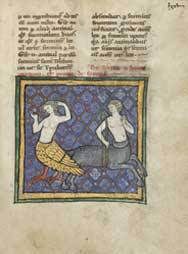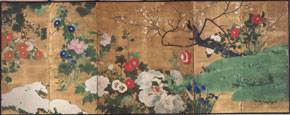
“A Siren and a Centaur,” Franco-Flemish, about 1270. Tempera colors, gold leaf, and ink on parchment. The J. Paul Getty Museum, Los Angeles, Ms. Ludwig XV 3, fol. 78.
Illuminated Manuscripts from Belgium and the Netherlands, at the Getty Museum The splendor of the late medieval courts of the dukes of Burgundy evokes the legend of Camelot. Its magnificence was expressed in lavish banquets, pageants, and tournaments, as well as luxury goods such as tapestries, paintings, metalwork, and illuminated manuscripts
On display, at the J. Paul Getty Museum, the Getty Center, August 24—November 7, 2010 and November 9, 2010—February 6, 2011
]]>
Source: Getty Museum
Illuminated Manuscripts from Belgium and the Netherlands looks closely at manuscripts from the regions that comprise present-day Belgium, the Netherlands, and parts of northern France. During the Middle Ages these areas flourished economically and artistically. By the 15th and 16th centuries, the towns of Bruges, Ghent, Antwerp, and Utrecht participated in one of the greatest flowerings of book illumination in Europe. The region’s colorful, naturalistically painted books were eagerly sought after across the continent.
As their popularity grew, these books were produced for an international clientele of princes, dukes, cardinals, bishops, and the wealthy. Such patrons included the dukes of Burgundy, who ruled much of the Netherlands by the mid-1400s. They saw themselves as ideal Christian knights and commissioned chronicles such as the History of Charles Martel (1463-72), included in the exhibition, to justify their political claims and glorify their own lineage. This manuscript was originally commissioned by Philip the Good before his death and later finished under the direction of his son, Charles the Bold.
Philip the Good was a patron of art and culture and commissioned more than sixty books during his lifetime. The lavishly illuminated manuscripts ordered by Philip the Good and his loyal courtiers had an extraordinary impact on the book trade, which attracted the finest artists, encouraged innovation, and dramatically raised the quality of book production overall.
Charles the Bold continued this trend: first by seeing that books begun by his father were completed, then by commissioning further works, and finally encouraging wider patronage at his own court, including his wife Margaret of York, Duchess of Burgundy (1446-1503).
Margaret of York commissioned one of the most beautiful and original books from this period, The Visions of the Knight Tondal (1475), also on view in this exhibition. This manuscript tells the story of a wealthy and errant Irish knight whose soul is led on a journey through hell and paradise to learn the wages of sin. The book was illuminated by Simon Marmion (ca. 1420-1489), one of the epochs greatest illuminators and also a successful painter in oil on panel.
Other major manuscript artists displayed in this exhibition include prolific Flemish illuminator Willem Vrelant (14541481), who was one of Bruges’s most successful artists; Lieven van Lathem (1430-1493), the court painter of Philip the Good; and Simon Bening (1483-1561), the finest Flemish illuminator of the 1500s, who became famous for his landscape settings.
Follow us on:

